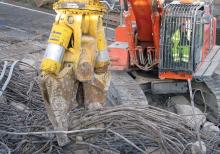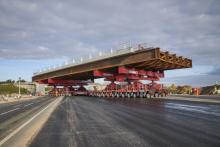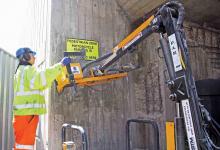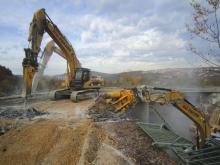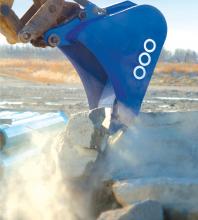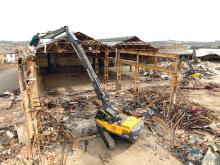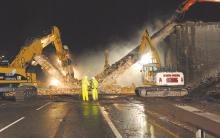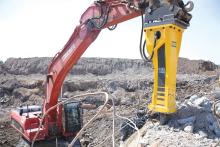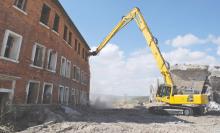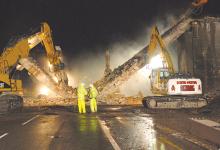Military-style planning and overwhelming demolition firepower ensured that Armac Group avoided financial penalties and the wrath of drivers on one of the UK’s busiest motorway intersections. Demolition & Dismantling reports. 6 January is traditionally known for the visit of the three wise men to Bethlehem. However, on 6 January 2012, three wise demolition engineers from Armac Group was tasked with dismantling the monumental structure known as Catthorpe Viaduct: the main overbridge of the M6/M1/A14 interc
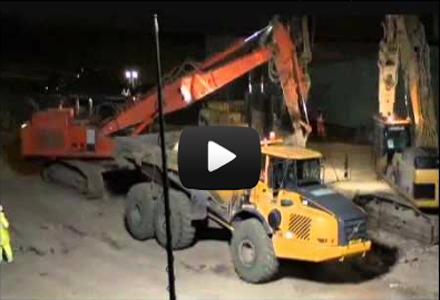
Original article published in the summer edition of Demolition & Dismantling Magazine, published by
Military-style planning and overwhelming demolition firepower ensured that Armac Group avoided financial penalties and the wrath of drivers on one of the UK’s busiest motorway intersections. Demolition & Dismantling reports.
The 4,500 tonne structure required dismantling due to the failed hinge joints which carried the suspended spans above the running lanes of the M1. The structure had been closely monitored over the past 15 years, and an additional Catch Prop structure had been constructed under the East Hinge in case of catastrophic failure.
Prior Planning
The detailed planning and design began as early as 2009 when design engineers from Armac’s specialist Rail & Civils division were requested by theBy mid 2010 the final design and target cost had been agreed and Armac were instructed to proceed to a detailed design stage. The selected dismantling method was progressive fragmentation of the structure using large demolition excavators and heavy demolition attachments with debris falling onto a protective layer of crane mats deployed to protect the existing carriageway. Although selected as the optimum method it still provided significant challenges.
The replacement viaduct had been designed and constructed as part of the wider remodelling of the M1/M6/A14 interchange. As a result, the new structure had to be constructed just 6 metres from the old structure to tie in with the new junction alignment. The close proximity of this structure provided one of the greatest challenges to the Armac design team. Detailed CAD modelling of the structures demonstrated that there was enough working space, but even so it meant that the demolition between the structures required detailed control on the night from the demolition engineers supervising the break out.
In addition, the length of the closure was a tough point of negotiation. Armac had originally proposed a single 48 hour closure from Friday midnight to Sunday midnight. However, the HA was reluctant to close this busy section of Motorway for such a long time and preferred a staged closure over three weekends with the central suspended spans and central leaf pier being removed under a full 18 hour closure and then the outside spans under separate 12 hour closures.
At £ 18,000 per hour penalties, the large time reduction certainly focused our mind,” says Armac’s Rail & Civils director Noel McLean. “But a detailed hour-by-hour programme and finite analysis of the critical path gave us the confidence that we could meet such a difficult timeline.’
Impressive Firepower
With some 4,000 tonnes of concrete, 500 tonnes of reinforcement steel and a three kilometre run to the tip area, a major logistical operation was planned by the Armac team. With all plant and equipment being delivered and removed from the project on a ‘just in time’ basis the project had assembled what is believed to be the largest ever assembly of demolition fire power for a bridge demolition comprising 14 hydraulic excavators ranging from 70 to 50 tonnes; two 7 tonne hydraulic breakers; four 6 tonne breakers; six 4 tonne beakers; four 6 tonne pulverisers; four 4 tonne hydraulic processors; two 7 tonne shears; and a fleet of 12 x 40 tonne payload dumptrucks.Behind the lead demolition machines was a full back up team of ground crews, plant technicians, hydraulic hose fitters, tyre fitter and hiab and standby excavators and attachments.
The demolition was undertaken over four 10 hour shifts with a one hour overlap between to allow for a smooth changeover and continuous working.
With the major publicity surrounding the closure and a low traffic count the motorway was closed on time and handed over to Armac engineers. The carriageway protection system was quickly installed and the first strike on the bridge was achieved ahead of programme.
As demolition progressed, it quickly became apparent that the supposedly failing structure was a worthy contender for the heavy demolition firepower that had been assembled.
“Breaking one metre thick concrete was never being going to be easy but add in 40 years of curing at 1N per year and 30 -50 mm reinforcement bar, and the challenge was on,” McLean says. Under the watchful eye of national press and senior HA staff just six metres away on the new structure, the demolition teams worked expediently from one shift through to the next reducing the structure to the ground, processing the arisings, clearing the material to the tip and clearing the protection system.
After 32 hours, the carriageway was handed back for barrier replacement and traffic was running back on time with all of the structure removed at midday Sunday.
“Having removed numerous bridge structures over the years, we will probably never remove anything on this scale again. But I am pleased we pulled it off successfully with no safety issues, all of the structure removed, the motorway reopened on time and without a scratch to the carriageway,” Noel McLean concludes. “On the whole it was a fantastic performance by all of the team.”
No video provider was found to handle the given URL. See the documentation for more information.

